In this blog post, we will explore multiple ways to manually sync Intune policies on Windows 10 and Windows 11 devices. Manually syncing forces your device to check in with Intune and receive the latest configuration profiles, compliance policies, and targeted application deployments.
You can always wait for the next scheduled Intune policy refresh, but that can take some time. If you are testing a new configuration profile, app deployment, or troubleshooting an issue, manually initiating a sync helps you confirm results quickly without waiting for the background cycle.
According to Microsoft, when you target a device or user with an action, Intune immediately sends a push notification to the device to trigger a check-in (for example, when you assign a new configuration profile, app, or remote action).
In production, users will usually not need to manually sync very often. For administrators and testers, however, manual sync is extremely helpful to validate new deployments and diagnose policy or app issues.
Contents
What happens when you force Intune device Sync
When you manually initiate an Intune sync, the device:
- Contacts the Intune service and checks for new or updated policies, apps, and remote actions.
- Downloads and applies any pending configuration profiles, compliance policies, and app assignments.
- Updates its status back to Intune so that you see the latest state in the Intune admin center.
For Windows, the manual sync you trigger from the Settings app, Company Portal, or Intune portal ultimately results in the OMADMClient engine connecting to Intune to process policy updates. This is particularly useful when you:
- Have just deployed or modified an Intune policy and want to see the result immediately.
- Are troubleshooting failed or stalled app deployments.
- Need to validate device compliance and Conditional Access behavior.
Requirements to Initiate Intune Device Sync
To initiate an Intune device sync from a Windows device, you must meet the following requirements:
- The Windows device must be enrolled in Intune.
- The device must be online and able to reach Intune endpoints and Windows push notification services.
- For Company Portal based methods, the Intune Company Portal app must be installed.
When Should You Manually Sync Intune Policies
Below are the typical scenarios when you may want to initiate a manual sync on a Windows device.
- During testing of Intune policies: When you create or update configuration profiles, compliance policies, app deployments, or PowerShell scripts and want to confirm that they have applied correctly as soon as possible.
- During troubleshooting: If you encounter issues with app installations, policy application, or device compliance, forcing a sync ensures that the device pulls the latest configuration before you dig deeper.
- Device has been offline for a long period: For devices that have been disconnected from the network, manually initiating a sync after they reconnect ensures they quickly receive all missed policies and updates.
- Fixing stalled app deployments: If an app deployment appears stalled or stuck in a pending state, forcing a device check-in can often help resume or re-evaluate the deployment.
Different Ways to Manually Force Initiate Intune Sync
There are several ways to manually initiate Intune sync from a Windows device or remotely:
- Using the Settings app on the device.
- Using the Company Portal app.
- Using the Start menu or desktop taskbar (Company Portal context menu)
- Using the Sync remote action in the Intune admin center
- Using bulk device actions in the Intune admin center
- Using PowerShell.
- Using Task Scheduler or deviceenroller.exe on the device to trigger the MDM sync task
- Using the Intune Management Extension sync URI (intunemanagementextension://syncapp) for Win32 apps and scripts
- Restarting IME service.
- Force execution of Intune device remediation scripts.
Intune Default Policy Sync Interval
Intune uses a combination of regular background check-ins and change-triggered syncs. The widely quoted “8-hour” figure refers to an approximate maintenance check-in, not the only time policies can be applied.
Ongoing (steady state) refresh interval
| Device platform | Estimated refresh cycle (steady state) |
|---|---|
| iOS / iPadOS | Around every 8 hours |
| macOS | Around every 8 hours |
| Android / Android AOSP | Around every 8 hours |
| Windows 10/11 PCs enrolled as devices | Around every 8 hours |
| Windows 8.1 | Around every 8 hours |
In addition to this, newly enrolled devices and devices that have just received changes check in more frequently for a period, as shown below.
Intune Policy Refresh Intervals for Recently Enrolled Devices
For devices that have recently enrolled or immediately after assignment, Intune uses a more aggressive refresh pattern before falling back to the 8-hour maintenance sync.
| Device Type | Refresh Cycle / Frequency |
| iOS/iPadOS | Every 15 minutes for 1 hour, and then around every 8 hours |
| macOS | Every 15 minutes for 1 hour, and then around every 8 hours |
| Android | Every 3 minutes for 15 minutes, then every 15 minutes for 2 hours, and then around every 8 hours |
| Windows 10/11 PCs enrolled as devices | Every 3 minutes for 15 minutes, then every 15 minutes for 2 hours, and then around every 8 hours |
| Windows 8.1 | Every 5 minutes for 15 minutes, then every 15 minutes for 2 hours, and then around every 8 hours |
The Intune Management Extension (IME), which processes Win32 apps and PowerShell scripts, has its internal sync cycle of about 60 minutes when checking for new content.
Now let us walk through each manual sync method.
Method 1: Force Initiate Intune Sync using Settings App
You can manually initiate Intune sync using the Windows Settings app on Windows 10 and Windows 11:
- Press Windows + I to open the Settings app.
- Go to Accounts > Access work or school.
- Select the connected work account (for example, NestorW@cloudinfra.net).
- Click Info under Managed by <your organisation name>.
- Scroll down to the Device sync status section and click Sync.
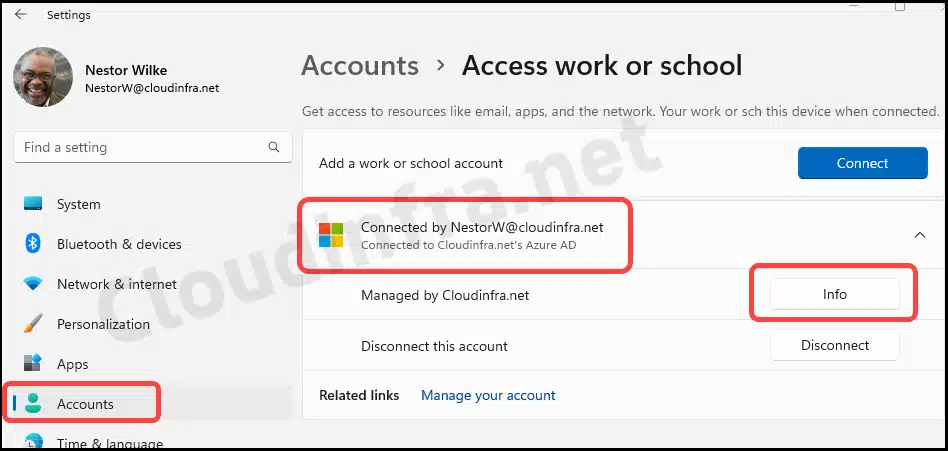
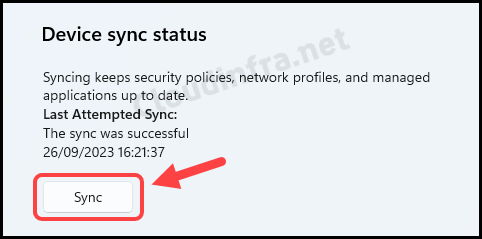
Method 2: Sync Intune Policies using the Company Portal app
You can also force a sync using the Company Portal app. If you have not yet deployed Company Portal, refer to the guide Deploy Company Portal App on Windows Using Intune.
- Launch the Company Portal app on the device.
- Click Settings at the bottom of the app window.
- Click the Sync button to initiate a device check-in with Intune.
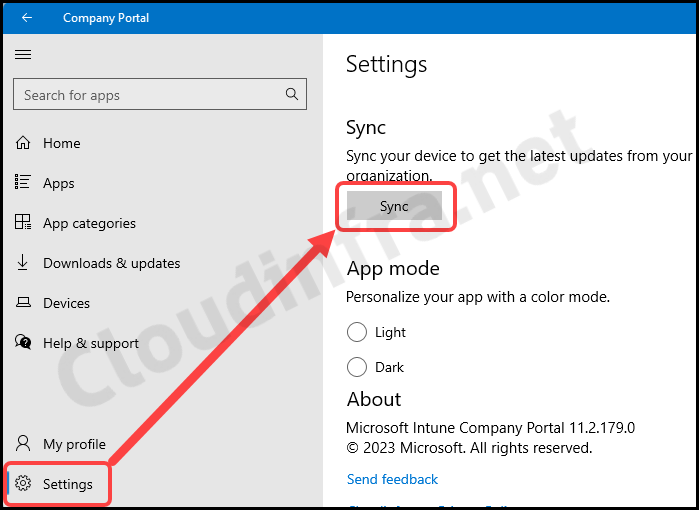
Method 3: Using the Start Menu or Desktop Taskbar
This method also uses the Company Portal app, but from its context menu:
- Locate the Company Portal icon in the Start menu or on the taskbar.
- Right-click the Company Portal icon.
- Select Sync this device.
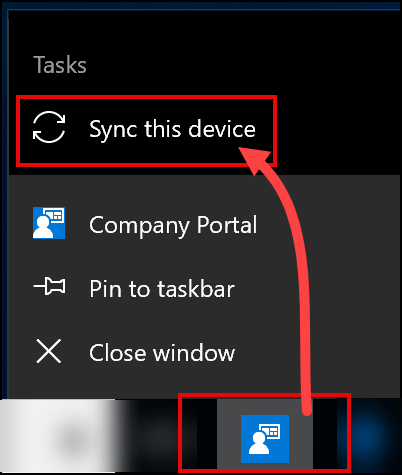
Method 4: Using Sync Action in the Intune Admin Center
This method does not require interactive access to the device. You can trigger device sync remotely from the Intune admin center:
- Sign in to the Intune admin center > Go to Devices > All devices.
- Search for and select the device you want to initiate sync on.
- On the device overview page, click Sync, then click Yes to confirm.
- Intune sends a push notification to the device, which causes it to wake up and check in.
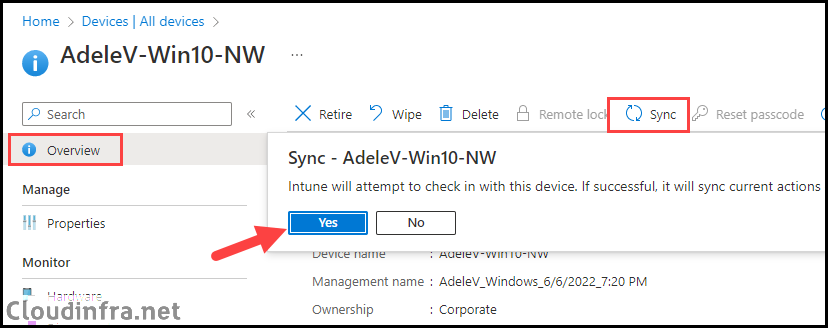
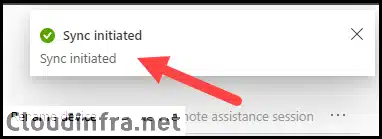
Method 5: Using Bulk Device Actions in the Intune Admin Center
If you would like to force sync on multiple devices at once, use bulk device actions.
- Sign in to the Intune admin center > Navigate to Devices > All devices and click Bulk device actions.

- Select the OS from the drop-down list (for example, Windows).
- For Device type, select Physical devices.
- For Device action, select Sync.

- On the Devices tab, click + Select devices to include and choose the devices you want to sync.
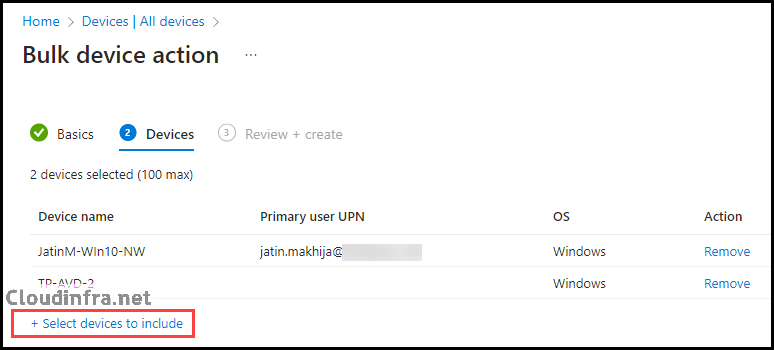
- Review the summary on the Review + Create page and click Create.
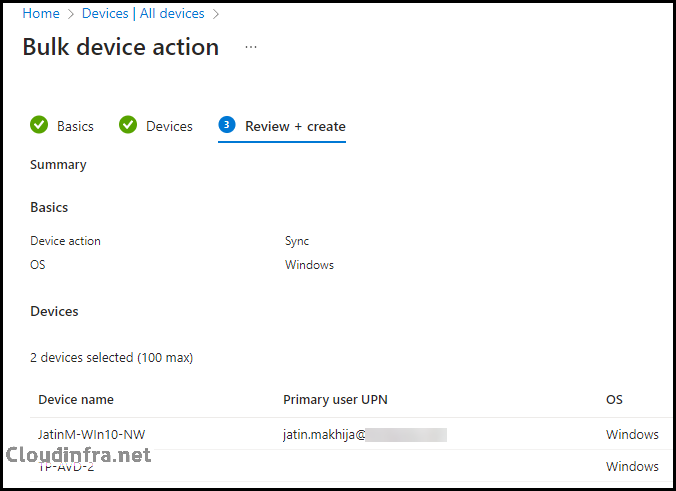

Method 6: Force Intune Sync using PowerShell
If you prefer the command line over GUI, you can also utilize Windows PowerShell to force the Initiate device check-in process with Intune. You can do this for either one device or multiple devices at once. To learn how to initiate Intune sync manually using PowerShell, refer to the link How To Force Intune Sync Using PowerShell.
Method 7: Trigger Intune Sync via Task Scheduler
On a Windows client, the MDM sync is ultimately handled by OMADMClient via scheduled tasks under \Microsoft\Windows\EnterpriseMgmt. When you click Sync in Settings or Company Portal, Windows is really kicking off those tasks.
- Open an elevated PowerShell console and execute the below command:
To trigger the Intune Sync
Get-ScheduledTask 'PushLaunch' | Start-ScheduledTaskConfirm the last run time of the scheduled task for Intune Sync
Get-ScheduledTask -TaskName 'PushLaunch' |
ForEach-Object {
Get-ScheduledTaskInfo -TaskName $_.TaskName -TaskPath $_.TaskPath
} |
Select-Object TaskName, TaskPath, LastRunTime, LastTaskResultYou might see LastTaskResult value 2192310788 (0x82AC0204), it means that the task is queued, will be run later, but not failed. To confirm the sync, check:
- DeviceManagement-Enterprise-Diagnostics-Provider logs in Event Viewer.
- Queued schedule task under EnterpriseMgmtNonCritical \Microsoft\Windows\EnterpriseMgmtNonCritical.
- the device’s last check-in time in Intune.
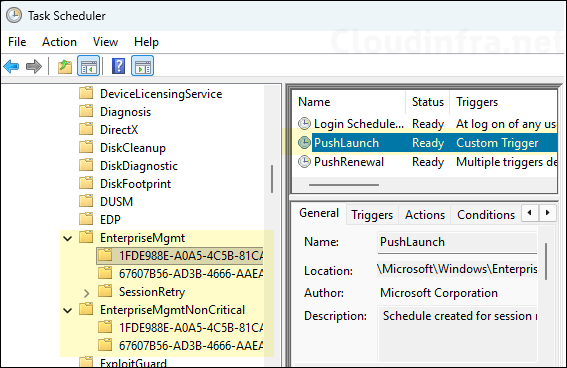
Method 8: Trigger Intune Sync using Intunemanagementextension://syncapp
For Win32 apps, PowerShell scripts, proactive remediations, etc., Intune Management Extension (IME) has its own sync mechanism.
- Press Win + R to open the Run dialog box.
- From Run dialog, type below command and press Enter to initiate the sync.
intunemanagementextension://syncapp
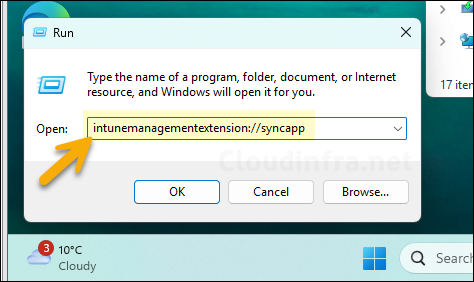
- You can verify whether the sync has been initiated by using the recently updated C:\ProgramData\Microsoft\IntuneManagementExtension\Logs\IntuneManagementExtension.log file. After you run the command, you will find that [Win32AppAsync] Starting app check in entry in the log to confirm that the sync has been initiated.

You can also use this in a PowerShell script and execute the script to initiate the Intune sync. IME/Win32-specific sync triggers Intune Management Extension to immediately check for new Win32 apps, scripts, and remediations. It does not replace normal MDM policy sync.
$Shell = New-Object -ComObject Shell.Application
$Shell.Open("intunemanagementextension://syncapp")Method 9: Trigger Intune Sync by Restarting Intune Management Extension (IME) Service
You can use below command to trigger Win32 app processing, which can be useful when troubleshooting Win32 app deployment issues.
- Open an elevated PowerShell console and run the below command:
Restart-Service IntuneManagementExtensionMethod 10: Force Intune Device Remediation Sync
Run remediation remote action lets you immediately execute an Intune remediation on a specific Windows device. It forces the Intune Management Extension to check in, run the detection script, and, if required, run the remediation script without waiting for the scheduled interval. To initiate a remediation remote action, follow the steps below:
- Sign in to the Intune admin center at https://intune.microsoft.com.
- In the left pane, go to Devices > All devices.
- Search for and select the Windows device where you want to run the remediation.
- On the device overview page, click the … (More) menu in the toolbar.
- Click Run remediation (preview).
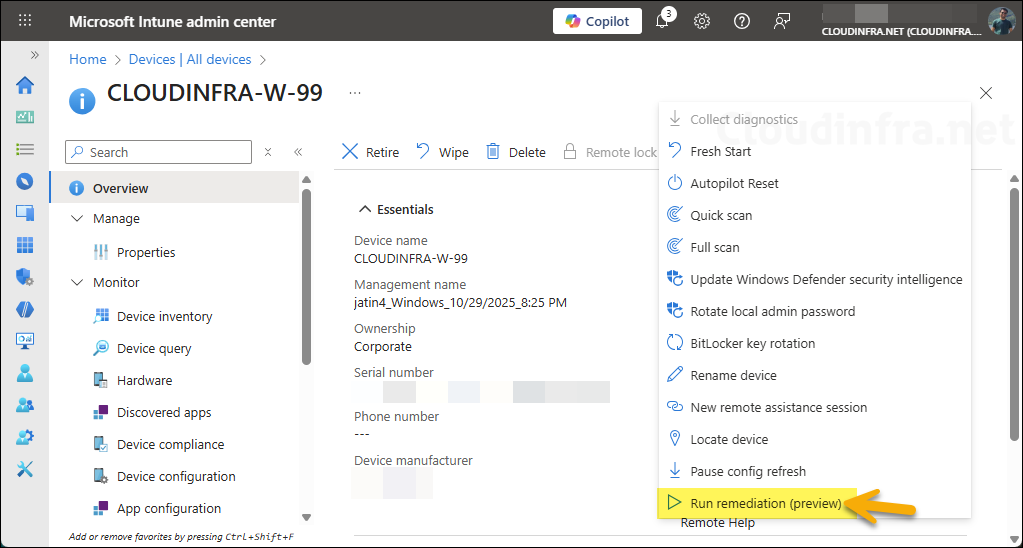
- In the Run remediation pane, select the remediation package you would like to execute from the list.
- (Optional) Review the detection and remediation scripts or settings by clicking on View details.
- Click Run remediation to confirm and start the on-demand run.

Monitoring Intune Policy Sync Information in Event Viewer
After initiating a sync, you can confirm activity and troubleshoot from Event Viewer. These logs are especially helpful when you need to understand exactly which CSPs and policies have applied to the device.
- Open Start > Event Viewer. Navigate to Applications and Services Logs > Microsoft > Windows > DeviceManagement-Enterprise-Diagnostics-Provider > Admin.
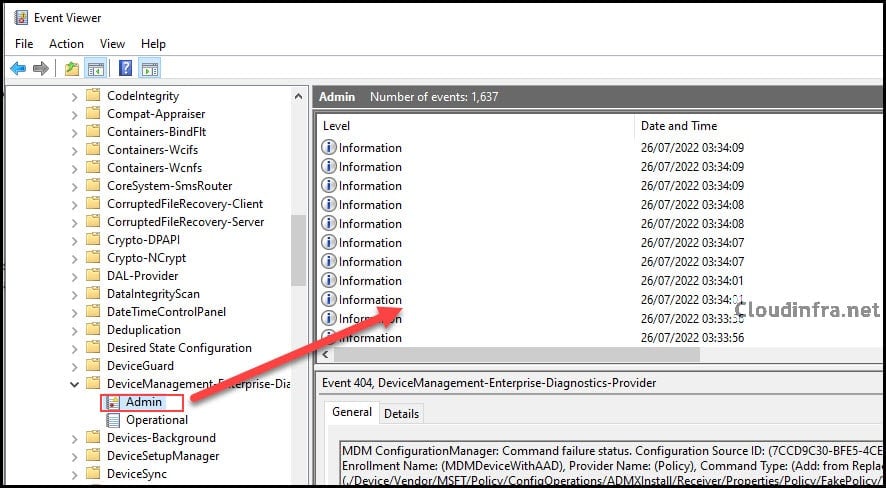
- When you perform an Intune sync, it also updates the IntuneManagementExtension.log file located at C:\ProgramData\Microsoft\IntuneManagementExtension\Logs\. For more details about this log file, refer to the post About Intune Management Extension (IME) Log Files.
